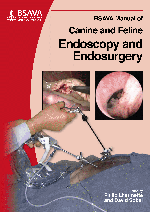
Full text loading...

PLEASE NOTE THAT A MORE RECENT EDITION OF THIS TITLE IS AVAILABLE IN THE LIBRARY
With skill and the right flexible endoscopic equipment, most parts of the gastrointestinal tract, major airways and lower urinary tract are now accessible, and many patients have benefitted from such endoscopic investigations. However, in some cases endoscopy may be unhelpful. Regrettably, endoscopy can result in serious complications, such as hypoxia during respiratory endoscopy and GI perforation during GI endoscopy. Minimum standards are applied to endoscopic proficiency in human medicine, and the veterinary profession should aspire to the same level. This chapter explains Safe use of the endoscope; Preparation for endoscopy; Handling the flexible endoscope; Using the controls; Using the endoscope in a patient; Biopsy techniques, handling and preparation; and Image recording.
Flexible endoscopy: basic technique, Page 1 of 1
< Previous page | Next page > /docserver/preview/fulltext/10.22233/9781905319572/9781905319572.3-1.gif

Full text loading...















